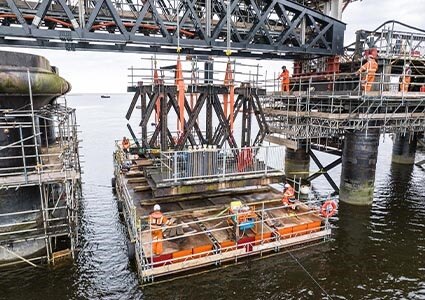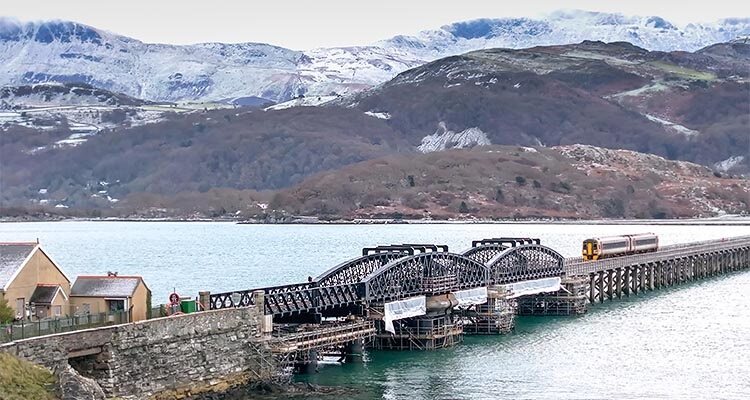Why Griffiths’ engineering expertise played a key role in the restoration of Barmouth Viaduct
Boasting over 50 years of experience and expertise, Griffiths is a sustainable civil engineering contractor with an interesting history. Founded in 1968 by Alun Griffiths, the business has grown to be one of the leading civil engineering and rail contractors throughout Wales, the Midlands, and Southwest England. With a focus on the rail, road, water, and utilities sectors, Griffiths delivers high-quality projects in a healthy, safe, and sustainable manner.
In 2018, Griffiths became part of Tarmac, the UK’s leading sustainable building materials business and a wholly owned subsidiary of CRH, one of the world’s leading materials companies. With access to Tarmac’s national and international network of contacts, resources, and expertise, Griffiths continues to grow in terms of market share, revenue, and industry innovation. 
At the end of 2023, Griffiths announced the completion of a milestone project – the restoration and refurbishment of Barmouth Viaduct, a single-track wooden railway viaduct crossing the estuary of the River Mawddach near Barmouth, Wales. Split over four years, Griffiths worked to carefully restore the 156-year-old viaduct on behalf of Network Rail and bring it back to its former glory, including replacing all the timber main beams.
As the longest timber viaduct in Wales and one of the oldest still in regular use in Britain, the bridge was in poor condition with many corroded metallic elements and decayed timber. The project entailed strengthening and upgrading both timber and metal elements, which included the complex task of moving two almost 200-tonne spans and reconstructing sections of the bridge. To further complicate the project requirements, the viaduct also holds Grade II listed status, meaning the refurbishment works had to replace components with similar products to maintain the bridge’s original appearance.
Griffiths successfully handed the structure back to Network Rail in November 2023 but continued with the final phase of the project to complete painting and remove temporary works. However, with over 400 tonnes of new steel and more than 1300 square metres of scaffolding required, as well as four major storms to navigate, the project was no mean feat and stands as testament to Griffiths’ dedication to excellence in infrastructure refurbishment.
Successful solutions
Having been involved with the Barmouth Viaduct project since the beginning, we’re joined by Steve Richardson, Engineering Manager, to learn more about the complexities and challenges. “I’ve been fully focused on the Barmouth Viaduct project for the last four years, but my involvement started before that when I completed minor steelworks and timberworks repairs on the track in a framework contract for Network Rail around six years ago,” Steve opens.
“At that time, a feasibility study was underway to explore all possible solutions for replacing the metallics work. The timberworks were more straightforward, as there are only a handful of effective techniques for directly replacing the timber, whereas reconstructing steel is more complicated. Once the tender for the timber scheme opened, we entered and later won the contract. Griffiths had previous experience of renewing timber for rail projects; there are nine timber rail viaducts in the UK, and we’ve worked on five of them.
“Building upon this experience, we created a relatively unique system for changing crossheads that support the decks, which didn’t require the deck and rails to be removed like in traditional methods. I think our proposal to change 24 crossheads without removing the track played a key role in us winning the initial contract. We changed the 24 crossheads within the 16 day blockade. The rest of the crossheads totalling 81 were replaced within a 14 week blockade.”
Complex operations 
Following the success of this contract, Griffiths went on to be awarded the contract for the metal works in late 2022. “Although I was in the role of operations manager, I transitioned to the position of engineering manager following the contract win, as I had been involved in the project since day one and knew its quirks and intricacies,” Steve recalls.
“We won the second contract based on our methodology; we drove the two main spans, which are approximately 40 metres long each, down the track and used the main beams as temporary support with the gantry system while we demolished the old one around it. This hasn’t really been done before; there have been similar activities over the years, but not to this extent or project type.
“I’m very pleased to tell you that we successfully delivered the contract within a 12-week blockade and handed back the track in December 2023. Network Rail then renewed an extra section of the track before the viaduct’s grand reopening.
“We’re now in the final phase of the project, to paint most of the entire system and joints,” he continues. “As you can imagine, it takes careful planning to find the right windows and conditions for painting. The substructure is painted other than any contact points, and we’re around 60 percent complete in terms of the actual deck painting, but we should be offsite at the end of May.”
However, Steve reiterates that the project wasn’t delivered without its fair share of complexities. When the company Griffiths contracted for the fabrication went into administration, Steve and his team had to identify a suitable alternative. “Finding a company with both rail facilities and the capability to conduct all the necessary trials proved impossible,” Steve explains.
“We eventually decided to carry out the trials ourselves. We kept around 100 metres of longitudinal timbers and track from the original viaduct, which we then laid on a long concrete slab to conduct our testing. We not only had to prove that the transport system would be able to drive seamlessly over the viaduct, but also that it would be able to stop safely.”
Remarkable restoration
With this in mind, Steve reflects on the lessons learned from the project: “The weather is always a tricky factor in the UK, but one that is out of our control, so we ensured there was always work that could be done in the event of adverse weather.
“Also, 3D drawings were invaluable. Having these drawings enabled us to visualise the entire process, and for future projects, I would incorporate 3D drawings much earlier in the process and include every element: the structure itself, temporary works, and possibly even the frame. Similarly, we had a full animation of the planned sequence created to help the team visualise how we were going to achieve the end goal. While there were still some last-minute changes, this helped us to plan strategically and identify potential issues.
“I look back with a huge degree of pride, from repairing the timber several years ago to seeing a new plaque installed to mark the restoration,” Steve concludes. “The entire team is incredibly proud of this achievement and many of us have purchased a copy of a print from a local artist who drew the various phases of reconstruction for the bridge, as a reminder of our involvement in the project.”

